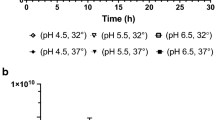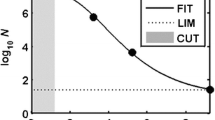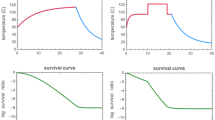Abstract
Geobacillus stearothermophilus is a thermophilic spore-forming bacterium which is used for intense thermal process validations (10 min–15 min). Several factors including the pH and heating medium influence the heat resistance of such microbial spores. In this study, the influence of using different buffer types including McIlvaine and phosphate was compared to distilled water at pH 7. Also, the effect of pH variations was studied using McIlvaine buffer at pH 3, 4, 5, 6, 7, and 8. All kinetics studies were conducted at 110 to 120 (°C). Results showed higher heat sensitivity (higher Z value) in distilled water (8.27 °C) than in phosphate (9.21 °C) and McIlvaine buffers (9.59 °C); likely being influenced by the high percentage of inorganic salts present in these buffers. The spores had the highest heat resistance at neutral pH, and the associated D values decreased both below and above pH 7.0. The pH effect on enhancing the heat sensitivity was higher at 110 °C, but the overall temperature influence was not significantly different (p > 0.05). Further, both first-order and Weibull models were compared for thermal destruction kinetics of G. stearothermophilus. Results demonstrated some concavity in the log-linear survival curves suggesting a slightly better fit for the Weibull model in some cases, but the model did not show any better prediction than the first-order model for a 3D lethality (Fo) value of 15 min. The combined effect of pH and temperature also showed cubic trends, and the Ea ranged between 240 and 398 (kJ) at pH 4–7.





Similar content being viewed by others
References
P. Richardson, Thermal technologies in food processing (Woodhead Publishing Limited, Cambdrige, 2001)
C.R. Stumbo, Thermobacteriology in food processing (Academic Press, New York, 1973)
Y. Shao, H.S. Ramaswamy, Clostridium sporogenes-ATCC 7955 spore destruction kinetics in milk under high pressure and elevated temperature treatment conditions. Food Bioprocess. Tech. 4(3), 458–468 (2011)
H.F. Hassan, H.S. Ramaswamy, Heat resistance of G. stearothermophilus and C. sporogenes in carrot and meat alginate purees. J. Food Process. Preserv. 35(3), 376–385 (2011)
A.A. Ghani, M.M. Farid, X.D. Chen, Theoretical and experimental investigation of the thermal inactivation of Bacillus stearothermophilus in food pouches. J. Food Eng. 51(3), 221–228 (2002)
T. Watanabe, S. Furukawa, J. Hirata, T. Koyama, H. Ogihara, M. Yamasaki, Inactivation of Geobacillus stearothermophilus spores by high-pressure carbon dioxide treatment. Appl. Environ. Microbiol. 69(12), 7124–7129 (2003)
H. Vatankhah, N. Zamindar, M.S. Baghekhandan, Heat transfer simulation and retort program adjustment for thermal processing of wheat-based Haleem in semi-rigid aluminum containers. J. Food Sci. Tech. 52(10), 6798–6803 (2015)
H. Vatankhah, N. Zamindar, M.S. Shahedi, Geometry simplification of wrinkled wall semi-rigid aluminum containers in heat transfer simulation. J. Agric. Sci. Tech. 18(1), 123–133 (2016)
A. Kacar, S. Avunduk, B. Omuzbuken, E. Aykin, Biocidal activities of a triterpenoid saponin and flavonoid extracts from the Erica manipuliflora salisb. Against microfouling bacteria. Int. J. Agric For. and Life Sci. 2(2), 40–46 (2018)
J.M. Jay, High-temperature food preservation and characteristics of thermophilic microorganisms. Modern Food Microbiology. 6th edn., (Aspen Publishers, Gaithersburg, 2000), pp. 341–362
H.W. Walker, Influence of buffers and pH on the thermal destruction of spores of Bacillus megaterium and Bacillus polymyxaa. J. Food Sci. 29(3), 360–365 (1964)
P.M. Periago, P.S. Fernández, M.C. Salmerón, A. Martınez, Predictive model to describe the combined effect of pH and NaCl on apparent heat resistance of Bacillus stearothermophilus. Int. J. Food Microbiol. 44(1), 21–30 (1998)
M. López, I. González, S. Condon, A. Bernardo, Effect of pH heating medium on the thermal resistance of Bacillus stearothermophilus spores. Int. J. Food Microbiol. 28(3), 405–410 (1996)
F. Rodrigo, C. Rodrigo, P.S. Fernandez, M. Rodrigo, A. Martınez, Effect of acidification and oil on the thermal resistance of Bacillus stearothermophilus spores heated in food substrate. Int. J. Food Microbiol. 52(3), 197–201 (1999)
J. Iciek, I. Błaszczyk, A. Papiewska, The effect of organic acid type on thermal inactivation of Geobacillus stearothermophilus spores. J. Food Eng. 87(1), 16–20 (2008)
M.H. Wells-Bennik, P.W. Janssen, V. Klaus, C. Yang, M.H. Zwietering, H.M. Den, Besten, Heat resistance of spores of 18 strains of Geobacillus stearothermophilus and impact of culturing conditions. Int. J. Food Microbiol. 291, 161–172 (2019)
P.S. Fernandez, M.J. Ocio, F. Rodrigo, M. Rodrigo, A. Martinez, Mathematical model for the combined effect of temperature and pH on the thermal resistance of Bacillus stearothermophilus and Clostridium sporogenes spores. Int. J. Food Microbiol. 32(1), 225–233 (1996)
D.J. Lynch, N.N. Potter, Effects of organic acids on thermal inactivation of Bacillus stearothermophilus and Bacillus coagulans spores in frankfurter emulsion slurry. J. Food Prot. 51(6), 475–480 (1988)
N. Finley, M.L. Fields, Heat activation and heat-induced dormancy of Bacillus stearothermophilus spores. Appl. Microbiol. 10(3), 231–236 (1962)
R. Li, X. Kou, L. Zhang, S. Wang, Inactivation kinetics of food-borne pathogens subjected to thermal treatments: a review. Int. J. Hyperther. 34(2), 177–188 (2018)
M.A. van Boekel, On the use of the Weibull model to describe thermal inactivation of microbial vegetative cells. Int. J. Food Microbiol. 74(1), 139–159 (2002)
H.S. Ramaswamy, M. Marcotte, Thermal processing. Food processing: principles and applications. (CRC Press, Boca Raton, 2005), pp. 68–168
R. Xiong, G. Xie, A.E. Edmondson, M.A. Sheard, A mathematical model for bacterial inactivation. Int. J. Food Microbiol. 46(1), 45–55 (1999)
M. Peleg, M.B. Cole, Reinterpretation of microbial survival curves. Crit. Rev. Food Sci. 38(5), 353–380 (1998)
A. Fernandez, C. Salmeron, P.S. Fernández, A. Martınez, Application of a frequency distribution model to describe the thermal inactivation of two strains of Bacillus cereus. Trends Food Sci. Technol. 10(4), 158–162 (1999) (1999)
H. Chen, Use of linear, Weibull, and log-logistic functions to model pressure inactivation of seven foodborne pathogens in milk. Food Microbiol. 24(3), 197–204 (2007)
J.U.H.E.E. Kim, H.B. Naylor, Spore production by Bacillus stearothermophilus.. Appl. Microbiol. 14(4), 690 (1966)
T.C. McIlvaine, A buffer solution for colorimetric comparison. J. Biol. Chem. 49(1), 183–186 (1921)
L. Durand, S. Planchon, M.H. Guinebretiere, F. Carlin, F. Remize, Genotypic and phenotypic characterization of foodborne Geobacillus stearothermophilus. Food Microbiol. 45, 103–110 (2015)
J. Maindonald, J. Braun, Data analysis and graphics using R: an example-based approach, 2nd edn. (Cambridge University Press, Cambridge, 2006)
T.N. Nazina, T.P. Tourova, A.B. Poltaraus, E.V. Novikova, A.A. Grigoryan, A.E. Ivanova, A.M. Lysenko, V.V. Perunyaka, G.A. Osipov, S.S. Belyaev, M.V. Ivanov, Taxonomic study of aerobic thermophilic bacilli: descriptions of Geobacillus subterraneus gen. nov., sp. nov. and Geobacillus uzenensis sp. nov. from petroleum reservoirs and transfer of Bacillus stearothermophilus. Bacillus thermocatenulatus, Bacillus thermoleovorans, Bacillus kaustophilus, Bacillus thermodenitrificans to Geobacillus as the new combinations G. stearothermophilus, G. th. Int. J. Syst. Evol. Microbiol. 51(2), 433–446 (2001)
P.T. Ting, A. Freiman The story of Clostridium botulinum: from food poisoning to Botox. Clin. Med. 4(3), 258–261 (2004)
E. Patazca, T. Koutchma, H.S. Ramaswamy, Inactivation kinetics of Geobacillus stearothermophilus spores in water using high-pressure processing at elevated temperatures. J. Food Sci. 71(3), M110–M116 (2006)
A.H. Geeraerd, V.P. Valdramidis, J.F. Van Impe, GInaFiT, a freeware tool to assess non-log-linear microbial survivor curves. Int. J. Food Microbiol. 102(1), 95–105 (2005)
G. Stone, B. Chapman, D. Lovell, Development of a log-quadratic model to describe microbial inactivation, illustrated by thermal inactivation of Clostridium botulinum. Appl. Environ. Microbiol. 75(22), 6998–7005 (2009)
S. Buzrul, H. Alpas, Modeling inactivation kinetics of food borne pathogens at a constant temperature. LWT Food Sci. Technol. 40(4), 632–637 (2007)
A. Fernandez, J. Collado, L.M. Cunha, M.J. Ocio, A. Martınez, Empirical model building based on Weibull distribution to describe the joint effect of pH and temperature on the thermal resistance of Bacillus cereus in vegetable substrate. Int. J. Food Microbiol. 77(1–2), 147–153 (2002)
Acknowledgements
This research was partially supported by the Discovery Grant from the Natural Sciences and Engineering Council (NSERC) of Canada.
Author information
Authors and Affiliations
Corresponding author
Additional information
Publisher’s Note
Springer Nature remains neutral with regard to jurisdictional claims in published maps and institutional affiliations.
Rights and permissions
About this article
Cite this article
Ramaswamy, H.S., Xu, M. & Vatankhah, H. Investigating the influence of pH and selected heating media on thermal destruction kinetics of Geobacillus stearothermophilus (ATCC10149). Food Measure 13, 1310–1322 (2019). https://doi.org/10.1007/s11694-019-00046-2
Received:
Accepted:
Published:
Issue Date:
DOI: https://doi.org/10.1007/s11694-019-00046-2




